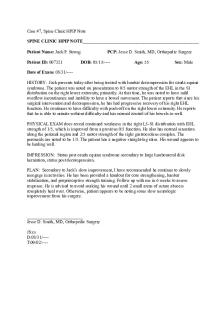Narrow Transcription - Professor McNamara (Unit 2) PDF

| Title | Narrow Transcription - Professor McNamara (Unit 2) |
|---|---|
| Author | Kelly Garcia |
| Course | Introduction to Applied Phonetics |
| Institution | Syracuse University |
| Pages | 4 |
| File Size | 168 KB |
| File Type | |
| Total Downloads | 105 |
| Total Views | 122 |
Summary
Professor McNamara (Unit 2)...
Description
Narrow Transcription Velar l is not always wrong It is an acceptable allophonic variation when it is postvocalic (at the end) Not as important for transcribing: (but we should know what the diacritics mean) Fronted or Advanced [p
Use this diacritic if… The tongue position is more anterior than would be expected for the sound in isolation… …but not so far forward as to represent a different phoneme
Retracted [b æ t] Use this diacritic if… The tongue position is more posterior than would be expected for the sound in isolation… …but not so far back as to represent a different phoneme.
Raised [b ɛ d] A raised tongue body position that is elevated above the usual, or target, position for a given vowel.
Lowered [h ɛ d] A lowered tongue body position is lower than the usual, or target, position for a sound.
ɑ t]
IMPORTANT:
A derhotacized sound is an /r/ consonant or an r-colored vowel that is significantly lacking in rhotic quality but does not fall clearly into another phonemic category of English. At an articulatory level, derhotacization often involves a lowering of the anterior tongue (rather than raising) and elevation of the tongue dorsum without tongue root retraction. Taking away the rhotic quality (/r/ quality) The symbol should be under the /r/
Sound Source Symbols
Partially Voiced [æ b s ə n t]
This diacritic is most frequently used to mark an unusual degree of voicing for a sound that is normally voiceless. Many normal speakers will partially voice the [s] in a word like absurd or absent because of the influence of the surrounding voiced sounds.
In partial devoicing, a voiced sound such as /g/ or /l/ is realized without all the phonetic cues that typically mark it as a voiced segment. Children have a tendency to partially devoice final obstruents. Final consonants often exhibit some degree of devoicing even in typical adult speech. Partial devoicing also commonly occurs in both child and adult speech when a liquid, nasal or glide occurs after a voiceless sound in a cluster.
Glottalized (or Creaky Voice) (IPA [ ɑ ])
Glottal fry
A glottalized sound has a creaky or irregular voice quality reflecting aperiodicity in the laryngeal vibratory pattern.
This quality frequently occurs when speech is produced with a low volume of air in the lungs, as at the end of a sentence.
A pervasive glottalized voice quality can be observed in the speech of some individuals with vocal pathologies, such as vocal fold nodules.
However, a creaky voice quality is not intrinsically pathological; glottalization can be observed in the speech of typical adults and children.
Breathy (or Murmured) [p l eɪ( ɪ ŋ]
Breathy voice quality is characterized by air escaping through the larynx during phonation.
The vocal folds vibrate but do not close adequately during the vibratory cycle to prevent a loss of air.
The escape of air through the vocal folds causes an [h]-like noise that combines with the voicing signal
Whistled (or Hissed)
Whistling, almost entirely restricted to fricatives, involves a sharply tuned noise source like that of normal whistling with the lips. This feature is most commonly heard with /s/ and / ʃ/.
A trilled sound is made with rapid, repetitive movements of alternating opening and closing, essentially vibratory in nature.
Do not commonly occur in American English, but may appear in international accents of English. Stop Release Symbols
Aspirated [tʰ ɑ p]
Aspirated: a sound, usually a stop consonant, made with a noise segment associated with air escaping through the glottis.
An aspirated stop has two intervals of noise, both of which are typically audible.
The first noise segment is the release burst.
This segment is followed by a generally longer interval of noise generated as air passes through the gradually closing vocal folds and the upper airway.
Put a box over symbols that you are unsure of...
Similar Free PDFs

Coldblooded Transcription
- 2 Pages

Unit 8- Professor Laura Koenig
- 16 Pages

Transcription Guidelines
- 13 Pages

Worksheet 8 - Transcription
- 6 Pages

6 Ex Allophonic Transcription
- 1 Pages

Interview Data Transcription
- 8 Pages

Transcription. Symbol set list
- 1 Pages
Popular Institutions
- Tinajero National High School - Annex
- Politeknik Caltex Riau
- Yokohama City University
- SGT University
- University of Al-Qadisiyah
- Divine Word College of Vigan
- Techniek College Rotterdam
- Universidade de Santiago
- Universiti Teknologi MARA Cawangan Johor Kampus Pasir Gudang
- Poltekkes Kemenkes Yogyakarta
- Baguio City National High School
- Colegio san marcos
- preparatoria uno
- Centro de Bachillerato Tecnológico Industrial y de Servicios No. 107
- Dalian Maritime University
- Quang Trung Secondary School
- Colegio Tecnológico en Informática
- Corporación Regional de Educación Superior
- Grupo CEDVA
- Dar Al Uloom University
- Centro de Estudios Preuniversitarios de la Universidad Nacional de Ingeniería
- 上智大学
- Aakash International School, Nuna Majara
- San Felipe Neri Catholic School
- Kang Chiao International School - New Taipei City
- Misamis Occidental National High School
- Institución Educativa Escuela Normal Juan Ladrilleros
- Kolehiyo ng Pantukan
- Batanes State College
- Instituto Continental
- Sekolah Menengah Kejuruan Kesehatan Kaltara (Tarakan)
- Colegio de La Inmaculada Concepcion - Cebu








